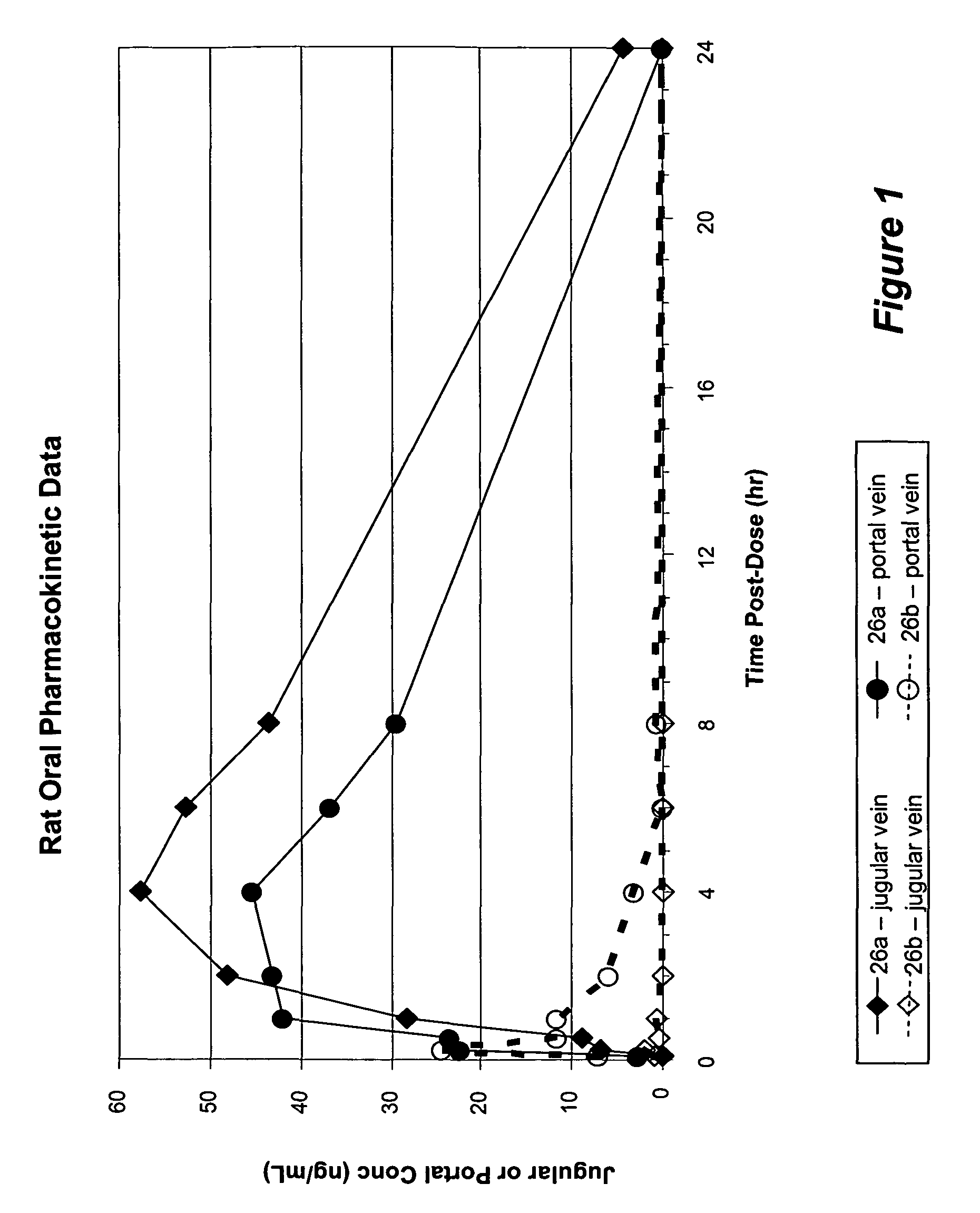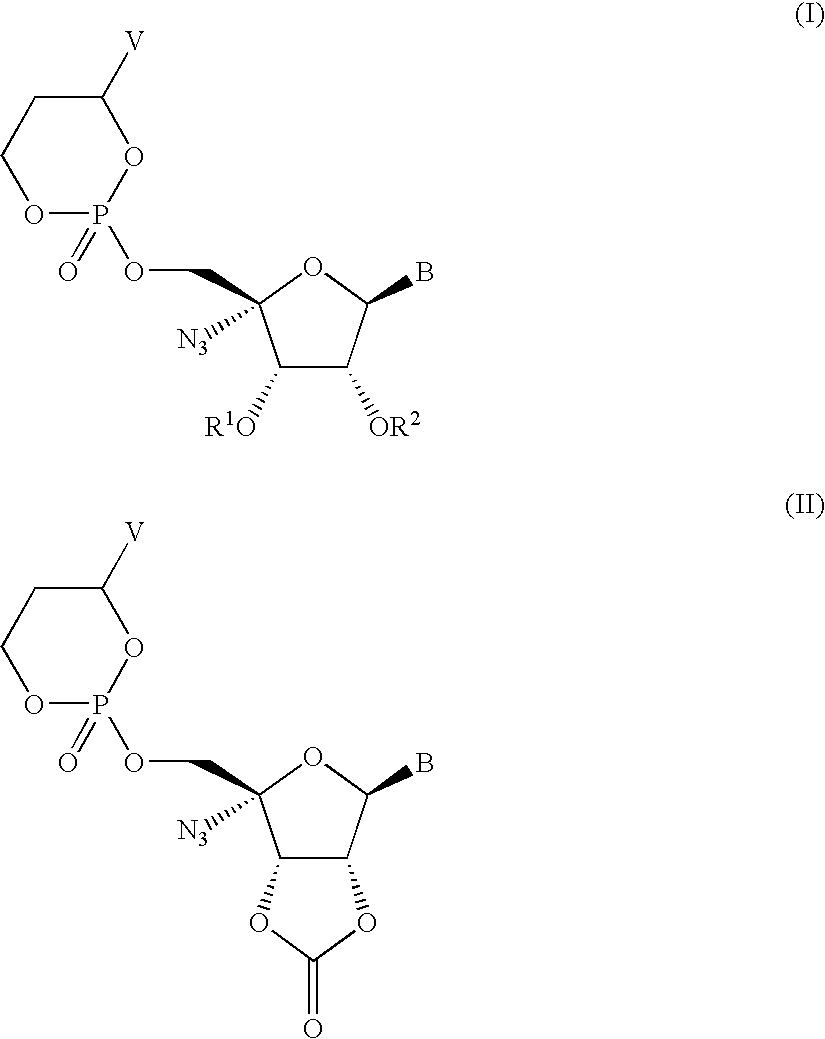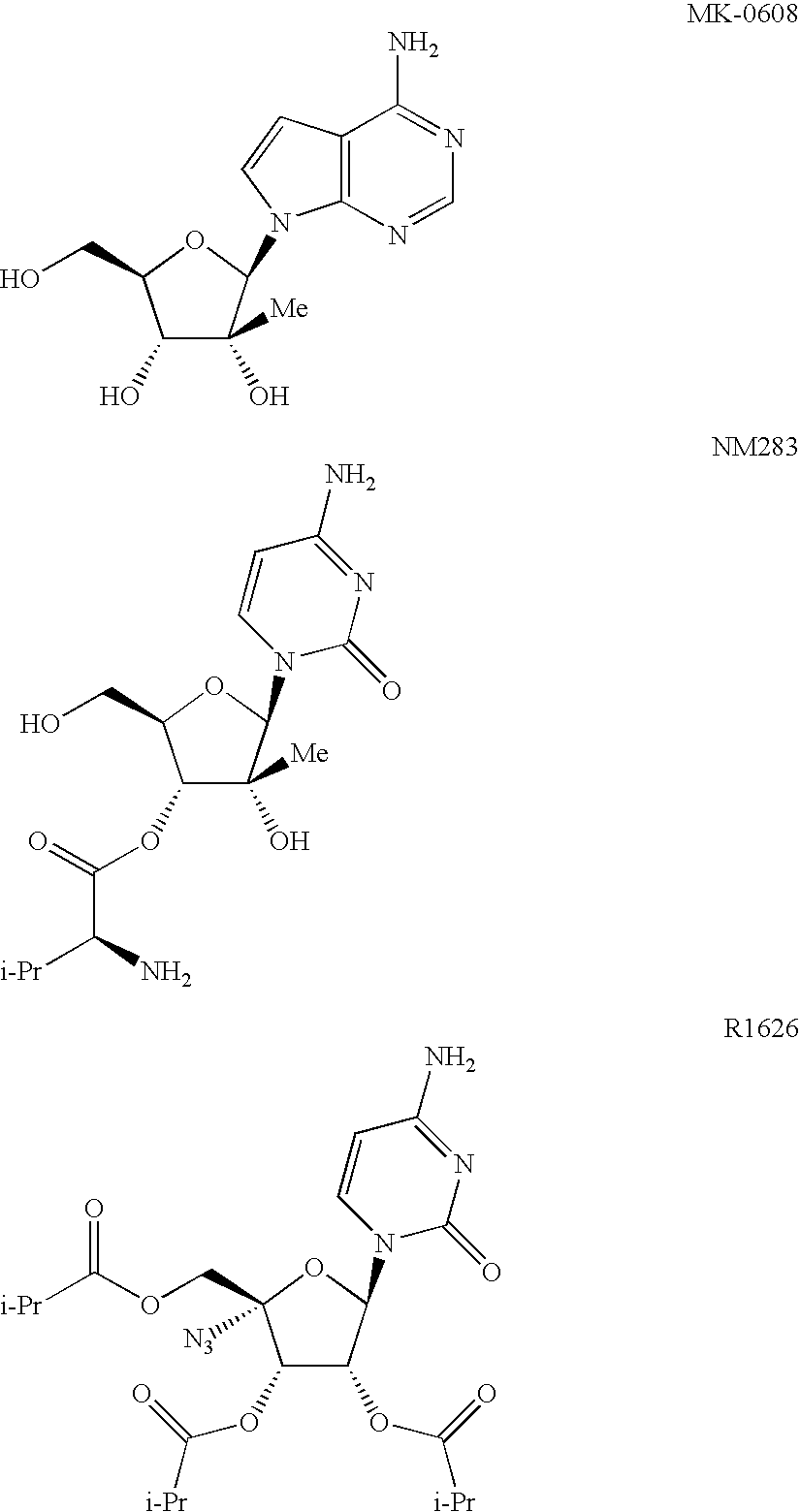Nucleoside prodrugs and uses thereof
a technology of nucleosides and prodrugs, applied in the field of nucleoside derivatives, can solve the problems of insufficient stability of prodrugs for in vivo application, differences in efficacy between these agents, and other advanced agents that have not achieved such dramatic efficacy, and achieve the effect of inhibiting the replication of hcv
- Summary
- Abstract
- Description
- Claims
- Application Information
AI Technical Summary
Problems solved by technology
Method used
Image
Examples
example 1
Preparation of 4′-azido-cis-5′-O-[4-(S)-(3-chlorophenyl)-2-oxo-1,3,2-dioxaphosphorinan-2-yl]-cytidine
[0106]
[0107]Step A: Preparation of 4′-azido-2′,3′-O-isopropylidenylcytidine- To a stirred solution of 4′-azidocytidine (3.0 g, 10.56 mmol), prepared as described in WO 05000864, in a 1:1 mixture of acetone (60 mL) and N,N-dimethylformamide (60 mL), under nitrogen atmosphere, were added p-toluenesulfonic acid (6.18 g, 32.5 mmol)) followed by 2,2-dimethoxypropane (60 mL). Progress of the reaction was monitored by TLC and the reaction was neutralized with an aqueous ammonia solution upon completion after 16 h. The reaction mixture was concentrated under reduced pressure and purified by column chromatography using 8% methanol in dichloromethane to obtain the desired product (1.5 g, 44%) as a white powder.
[0108]Step B: Preparation of 4′-azido-cis-5′-O-[4-(S)-(3-chlorophenyl)-2-oxo-1,3,2-dioxaphosphorinan-2-yl]-2′,3′-O-isopropylidenylcytidine- To a stirred solution of 4′-azido-2′,3′-isopro...
example 2
Preparation of 4′-azido-cis-5′-O-[4-(S)-(3-Chlorophenyl)-2-oxo-1,3,2-dioxaphosphorinan-2-yl]uridine
[0110]
[0111]Step A: Preparation of 4′-azido-2′,3′-O-isopropylidenyluridine-4′-azido-2′,3′-O-isopropylidenyluridine was prepared from 4′-azidouridine (prepared as described in WO 05000864) as described in Step A of Example 1 (650 mg, 71%). TLC (SiO2) Rf: 0.50 in 10% MeOH-dichloromethane;
[0112]1H NMR (500 MHz, DMSO-d6) δ 1.32 (s, 3H), 1.58 (s, 3H), 3.61 (dd, 1H, J=12.6 Hz), 3.64 (dd, 1H, J=12.6 Hz), 4.97 (d, 1H, J=7 Hz), 5.12 (dd, 1H, J=7.3 Hz), 5.64 (t, 1H, J=6 Hz), 5.67 (dd, 1H, J=8.1 Hz), 6.04 (d, 1H, J=2 Hz), 7.79 (d, 1H, J=8 Hz), 11.48 (s, 1H).
[0113]
[0114]Step B: Preparation of 4′-azido-cis-5′-O-[4-(S)-(3-chlorophenyl)-2-oxo-1,3,2-dioxaphosphorinan-2-yl]-2′,3′-O-isopropylidenyluridine- The prodrug formation of 2′,3′-isopropylidinyl-4′-azidouridine was done as described in Step B of Example 1 (110 mg, 64%). 1H NMR (500 MHz, DMSO-d6) δ 1.33 (s, 3H), 1.60 (s, 3H), 2.16-2.30 (m, 2H), 4....
example 3
Preparation of 2′,3′-O-bis-acetyl-4′-azido-cis-5′-O-[4-(S)-(3-chlorophenyl)-2-oxo-1,3,2-dioxaphosphorinan-2-yl]uridine
[0117]
[0118]To a solution of 4′-azido-cis-5′-O-[4-(S)-(3-chlorophenyl)-2-oxo-1,3,2-dioxaphosphorinan-2-yl]uridine (Example 2) (502 mg, 0.973 mmol) in THF (5.0 mL) at 0° C. was added N,N-diisopropylethylamine (1.29 mL, 7.81 mmol) and 4-dimethylaminopyridine (61.3 mg, 0.502 mmol), followed by acetic anhydride (0.55 mL, 5.82 mmol). The reaction mixture was stirred at room temperature for 60 min, then diluted with aqueous saturated sodium bicarbonate (20 mL) and extracted with ethyl acetate (2×20 mL). The organic layer was rinsed with water (20 mL) and brine (20 mL), dried (Na2SO4), and evaporated. The crude product was purified by column chromatography on silica gel, eluted with dichloromethane-methanol (97:3) to afford 360 mg (88%) of the title compound as a white solid: 1H NMR (500 MHz, DMSO-d6) δ 2.06 (s, 3H.) 2.09 (s, 3H), 2.26 (m, 2H), 4.37 (d, 2H, J=6.5 Hz), 4.54 ...
PUM
| Property | Measurement | Unit |
|---|---|---|
| particle size | aaaaa | aaaaa |
| temperature | aaaaa | aaaaa |
| flow rate | aaaaa | aaaaa |
Abstract
Description
Claims
Application Information
 Login to View More
Login to View More - R&D
- Intellectual Property
- Life Sciences
- Materials
- Tech Scout
- Unparalleled Data Quality
- Higher Quality Content
- 60% Fewer Hallucinations
Browse by: Latest US Patents, China's latest patents, Technical Efficacy Thesaurus, Application Domain, Technology Topic, Popular Technical Reports.
© 2025 PatSnap. All rights reserved.Legal|Privacy policy|Modern Slavery Act Transparency Statement|Sitemap|About US| Contact US: help@patsnap.com



